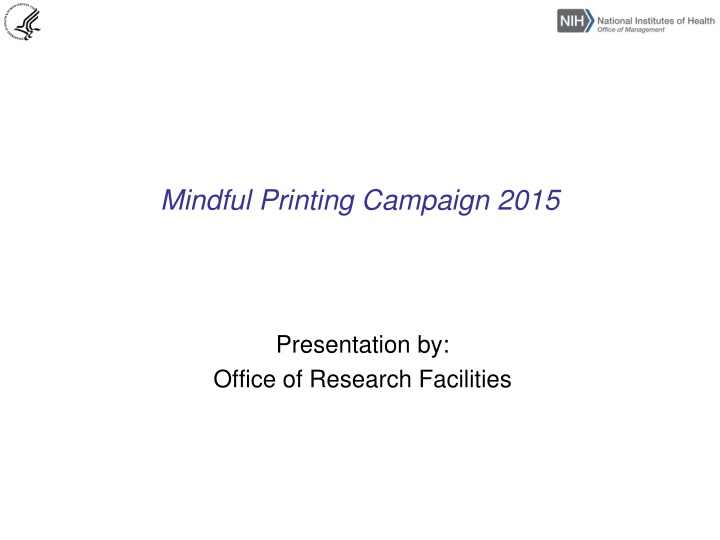Mindful Printing Campaign 2015 - HHS Logo Style One
This presentation by the Office of Research Facilities introduces the Mindful Printing Campaign of 2015 by NIH. It encourages minimizing printing and maximizing recycling to reduce paper waste. The campaign offers tips on adopting a mindful printing attitude, hosting paperless meetings, proofreading documents electronically, and using network printers efficiently to save costs and reduce waste.
Download Presentation

Please find below an Image/Link to download the presentation.
The content on the website is provided AS IS for your information and personal use only. It may not be sold, licensed, or shared on other websites without obtaining consent from the author.If you encounter any issues during the download, it is possible that the publisher has removed the file from their server.
You are allowed to download the files provided on this website for personal or commercial use, subject to the condition that they are used lawfully. All files are the property of their respective owners.
The content on the website is provided AS IS for your information and personal use only. It may not be sold, licensed, or shared on other websites without obtaining consent from the author.
E N D
Presentation Transcript
HHS Logo Style One (.gif) Mindful Printing Campaign 2015 Presentation by: Office of Research Facilities
HHS Logo Style One (.gif) Mindful Printing Campaign 2015 NIH is kicking off a Mindful Printing Campaign for the month of February 2015. Purpose: We would like to encourage everyone to minimize their printing, and thank those of you who already minimize your printing and maximize your recycling. Facts about NIH printing: In 2014, NIH recycled 660 tons of paper which is equivalent to 16,500 sheets of paper per employee. This is a massive amount of printing per person. We would like to encourage everyone to consider ways to minimize their printing and paper use. 2
HHS Logo Style One (.gif) Mindful Printing Toolbox Fact Sheet How to Host Paperless Meetings Fact Sheet Paper Reduction Flyer Thank you for Using a Network Printer Quiz with answers Presentation Mindful Printing Global Email All items can be found at: 3
HHS Logo Style One (.gif) Paper Reduction Tips Adopt and promote a Mindful Printing attitude. Think twice before you print. When less than the full document is needed, print a custom range of only the pages that are needed. Share documents with your colleagues as electronic files, rather than as paper copies. For items that must be printed, confirm the number of copies that are needed to avoid making extra copies. Adopt an organizational policy which instructs employees to use duplex printing and requires the procurement of copiers and printers that have the capability to duplex print. Then ensure that computer and copier default settings are set to duplex print. 4
HHS Logo Style One (.gif) Paper Reduction Tips Preview and proofread documents as much as possible on the computer monitor before printing. Keep copiers and printers in good repair. Schedule maintenance for copiers that are performing poorly, and report error and alert messages, such as low toner warnings. Copiers operating with low toner jam more frequently and waste paper. To avoid paper jams which waste paper, fill copier trays correctly. Some paper is directional, and should be loaded into the copier tray according to the arrows shown on the packaging. Learn to host paperless meetings. Project the meeting agenda and materials on a screen, rather than distributing paper copies. Share materials electronically with meeting attendees before the meeting. Take notes on a laptop, and distribute them to the attendees electronically. 5
HHS Logo Style One (.gif) Printer Reduction Encourage employees to use network printers and reduce individual printers. NIH has approximately 12,000 network printers, and a staggering 14,000 individual printers. The cost to print per page is approximately 30x cheaper with a network printer than an individual printer! Ratio of people to printers at NIH is 1:1 Using network printers saves the NIH money 6
HHS Logo Style One (.gif) Paperless Meetings Use emails, or a web application like Microsoft SharePoint to share meeting materials prior to the actual meeting. As the host, let your meeting attendees know that you will not be providing paper copies of the materials at the meeting. Meeting attendees can bring paper copies if necessary. During the meeting, display the meeting agenda and the presentation materials on the screen. Provide options for members to attend the meeting remotely. Implement a conference call number and/or an online meeting space. 7
HHS Logo Style One (.gif) Paperless Meetings Take meeting notes and attendance with your laptop or a hand held device. After the meeting, post the meeting notes on a SharePoint site or distribute them through email. If you need volunteer participation, try using online sign up tools such as Sign-up-Genius . If you need to collect data, try using an online survey tool, such as Survey Monkey . 8
HHS Logo Style One (.gif) Guide to Printing and Publication Services Most NIH traditional printing and publishing procurement such as employee newsletters, pamphlets, brochures, advertisement, graphic art work, research posters and outreach materials etc., are readily adaptable to green printing practices often at no or low cost. Many federal print contractors offer green printing services, if you ask! When considering a new print job, ask for the following: Responsible Paper Sourcing (see http://www.rit.edu/upub/going-green- glossary-terms-and-marks): Specify paper with 30% or GREATER post-consumer recycled fiber PCW Use Processed Chlorine Free PCF or Totally Chlorine Free TCF paper (dioxin, a carcinogen is often used to bleach paper and lasts forever), Consider specifying certified papers with logo to indicate paper from well managed forests adhering to strict environmental standards, such as: Forest Stewardship Council (FSC), Program for the Endorsement of Forest Certification (PEFC) Sustainable Forestry Initiative (SFI) 9
HHS Logo Style One (.gif) Guide to Printing and Publication Services Environmentally Friendly Inks: Vegetable oil-based inks that are made with < 3% volatile organic compounds (VOC) (still produces great images but pollutes less) Low VOC print processes e.g. solvent-free UV or water-based aqueous coatings Sustainability Messaging: Make the health and sustainability connection, enhance your product and acknowledge green printing with a foot note on the finished product. Example: Promoting health through responsible printing: 100% Recycled Content, 100% post-consumer waste, processed chlorine free using low VOC vegetable based inks [Include appropriate logos) 10
HHS Logo Style One (.gif) Guide to Printing and Publication Services Environmentally Friendly Inks: Vegetable oil-based inks that are made with < 3% volatile organic compounds (VOC) (still produces great images but pollutes less) Low VOC print processes e.g. solvent-free UV or water-based aqueous coatings Sustainability Messaging: Make the health and sustainability connection, enhance your product and acknowledge green printing with a foot note on the finished product. Example: Promoting health through responsible printing: 100% Recycled Content, 100% post-consumer waste, processed chlorine free using low VOC vegetable based inks [Include appropriate logos) 11
HHS Logo Style One (.gif) NIH Sustainability Goals Federal sustainability requirements include: Reduce greenhouse gases Advance sustainable acquisition of products and services Promote and prevent pollution, and minimize the toxics acquired, used, or disposed Increase use of acceptable alternative chemicals Use 30% or > recycled content paper and reduce printing paper use For more information see Executive Order 13514 and 13423. 12
HHS Logo Style One (.gif) Reducing Paper before a Move Is your office moving? Is your office too crowded? Sort your paper into 3 piles Recycle/ Shred Scan (then shred) Retain and keep Be careful! Read NIH Manual Chapter 1743 More information can also be found with Records Management 13
HHS Logo Style One (.gif) Questions Danita Broadnax or Terry Leland Division of Environmental Protection, ORF, NIH (301) 496-7775 14























